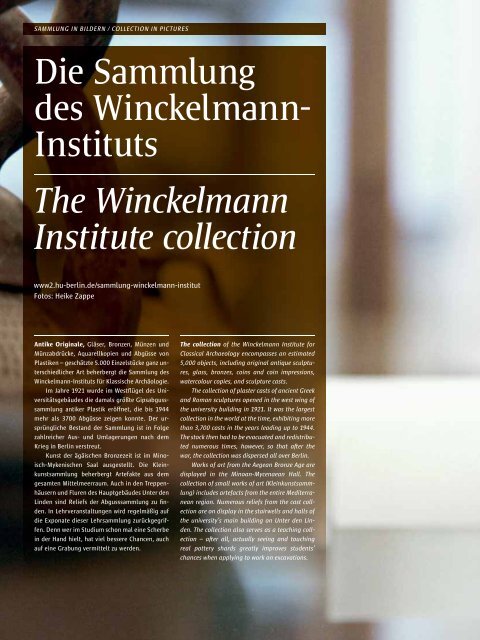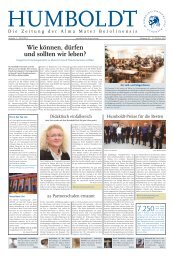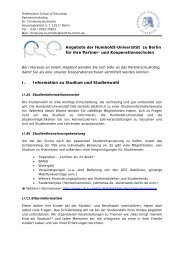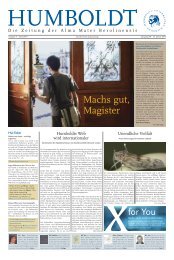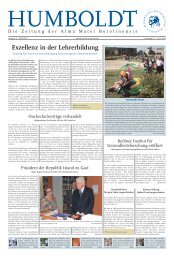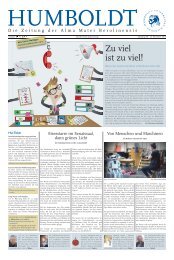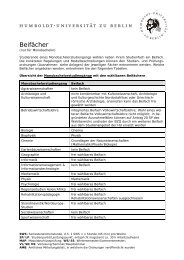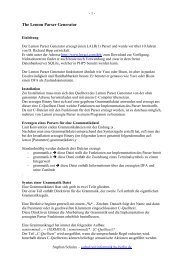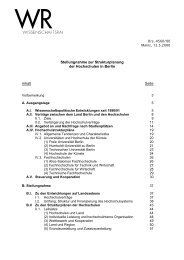hu wissen 3 (pdf) - Humboldt-Universität zu Berlin
hu wissen 3 (pdf) - Humboldt-Universität zu Berlin
hu wissen 3 (pdf) - Humboldt-Universität zu Berlin
Erfolgreiche ePaper selbst erstellen
Machen Sie aus Ihren PDF Publikationen ein blätterbares Flipbook mit unserer einzigartigen Google optimierten e-Paper Software.
SAMMLUNG IN BILDERN / COLLECTION IN PICTURES<br />
Die Sammlung<br />
des Winckel mann-<br />
Instituts<br />
The Winckelmann<br />
Institute collection<br />
www2.<strong>hu</strong>-berlin.de/sammlung-winckelmann-institut<br />
Fotos: Heike Zappe<br />
Antike Originale, Gläser, Bronzen, Münzen und<br />
Münzabdrücke, Aquarellkopien und Abgüsse von<br />
Plastiken – geschätzte 5.000 Einzelstücke ganz unterschiedlicher<br />
Art beherbergt die Sammlung des<br />
Winckelmann-Instituts für Klassische Archäologie.<br />
Im Jahre 1921 wurde im Westflügel des Universitätsgebäudes<br />
die damals größte Gipsabgusssammlung<br />
antiker Plastik eröffnet, die bis 1944<br />
mehr als 3700 Abgüsse zeigen konnte. Der ursprüngliche<br />
Bestand der Sammlung ist in Folge<br />
zahlreicher Aus- und Umlagerungen nach dem<br />
Krieg in <strong>Berlin</strong> verstreut.<br />
Kunst der ägäischen Bronzezeit ist im Minoisch-Mykenischen<br />
Saal ausgestellt. Die Kleinkunstsammlung<br />
beherbergt Artefakte aus dem<br />
gesamten Mittelmeerraum. Auch in den Treppenhäusern<br />
und Fluren des Hauptgebäudes Unter den<br />
Linden sind Reliefs der Abgusssammlung <strong>zu</strong> fi n-<br />
den. In Lehrveranstaltungen wird regelmäßig auf<br />
die Exponate dieser Lehrsammlung <strong>zu</strong>rückgegriffen.<br />
Denn wer im Studium schon mal eine Scherbe<br />
in der Hand hielt, hat viel bessere Chancen, auch<br />
auf eine Grabung vermittelt <strong>zu</strong> werden.<br />
The collection of the Winckelmann Institute for<br />
Classical Archaeology encompasses an estimated<br />
5,000 objects, including original antique sculptures,<br />
glass, bronzes, coins and coin impressions,<br />
watercolour copies, and sculpture casts.<br />
The collection of plaster casts of ancient Greek<br />
and Roman sculptures opened in the west wing of<br />
the university building in 1921. It was the largest<br />
collection in the world at the time, exhibiting more<br />
than 3,700 casts in the years leading up to 1944.<br />
The stock then had to be evacuated and redistributed<br />
numerous times, however, so that aer the<br />
war, the collection was dispersed all over <strong>Berlin</strong>.<br />
Works of art from the Aegean Bronze Age are<br />
displayed in the Minoan-Mycenaean Hall. The<br />
collection of small works of art (Kleinkunstsammlung)<br />
includes artefacts from the entire Mediterranean<br />
region. Numerous reliefs from the cast collection<br />
are on display in the stairwells and halls of<br />
the university’s main building on Unter den Linden.<br />
The collection also serves as a teaching collection<br />
– aer all, actually seeing and touching<br />
real pottery shards greatly improves students’<br />
chances when applying to work on excavations.<br />
54


